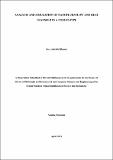| dc.description.abstract | The study of fluid flow and heat transfer through a cylindrical pipe and channel with porous boundaries are important research area due to its wide range of applications in engineering and industrial processes. Some practical applications include problems dealing with transpiration cooling, gaseous diffusion in order to produce fuel for nuclear reactors, controlling boundary layer flow over aircraft wings by injection or suction of fluid out of or into the wing, lubrication of porous bearings, petroleum technology, ground water hydrology, seepage of water in river beds, purification and filtration pr ocesses. A nanofluid is the suspension of nanoparticles in a base fluid. Nanofluids are promising for heat transfer enhancement due to their high thermal conductivity. For practical applications of nanofluids research in nanofluids convection are important. Owing to their enhanced properties, nanofluids can be used in a plethora of technical and biomedical applications such as nanofluid coolant which include electronics cooling, vehicle cooling, transformer cooling, computers cooling and other electronic devices cooling. Other applications are medical applications which include magnetic drug targeting, cancer therapy and safer surgery by cooling. This study considered the detailed analysis of laminar flow behavior and heat transfer using this innovative fluid as working fluid through a pipe and channel with porous boundaries for both steady and unsteady scenarios. We considered water-based nanofluids where copper and alumina were used as nanoparticles. The appropriate mathematical models for the problems were derived from the laws of conservation of mass, momentum and energy balance. The governing nonlinear Partial Differential Equations (PDE) and boundary conditions were converted into nonlinear Ordinary Differential Equations (ODE) using appropriate similarity transformations for the case of steady state formulated model and method of lines when unsteady situation was considered. These equations were solved analytically by regular perturbation methods with series improvement technique and numerically using an efficient Runge-Kutta-Fehlberg integration technique coupled with shooting scheme and multidimensional Newton-Raphson root finding technique. In chapter 1, the key concepts and derivations related to fluid flow, the statement of the problem, the objectives of the study, Significance of the study and the methodology are given. In chapter 2, the heat transfer characteristics of Berman flow of water-based nanofluids in a porous channel with Navier slip, viscous dissipation and convective cooling is investigated. Chapter 3 the combined effect of variable viscosity, Brownian motion, thermophoresis and convective cooling
i
on unsteady flow of nanofluid in a cylindrical pipe with permeable wall are analysed. In chapter 4 we investigates the effects of buoyancy force and variable viscosity on unsteady flow and heat transfer of water-based nanofluid containing Copper and Alumina as nanoparticles. Analysis of unsteady water-based nanofluid flow in a permeable cylindrical pipe through saturated porous medium with the effect of buoyancy-driven force, variable viscosity and Navier slip are examined. Theusefulresultsforthevelocity,temperature,nanoparticlesconcentrationprofiles, pressure gradient, skinfriction and Nusseltnumber were obtained and discussed quantitatively. Theeffectsofimportantgoverningflowparametersontheentireflowstructurewereexamined. The conclusion remarks are carried out in chapter 6. | en_US |

